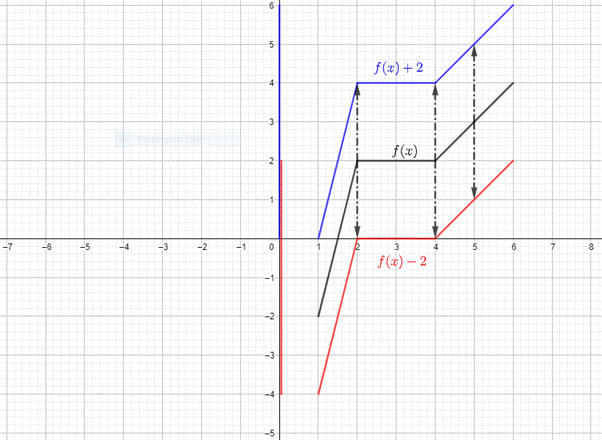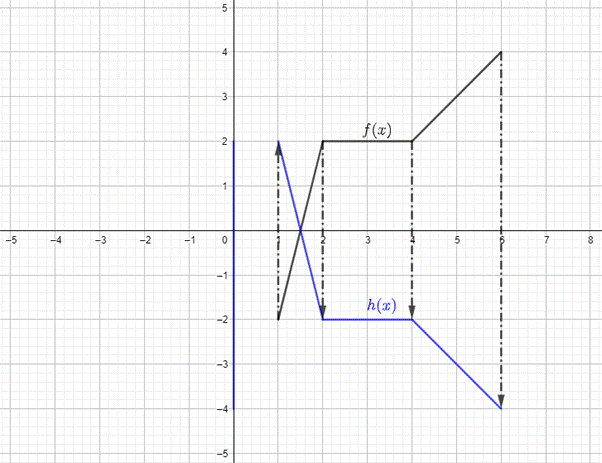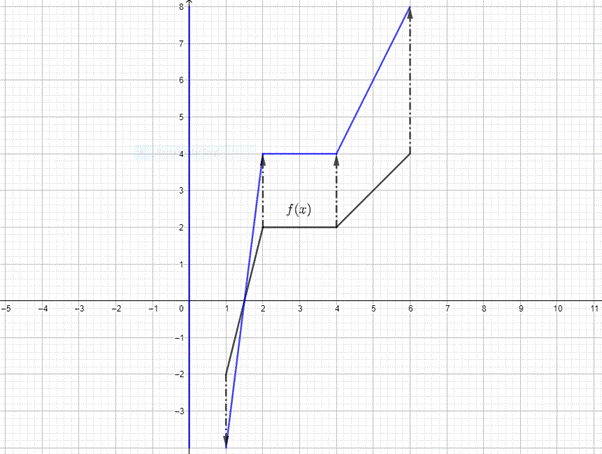
a.
To compare the domain and range of the transformed functions with that of the parent function.
A vertical translation of
During reflection about
A vertical stretch by a factor of
A horizontal translation of
Given the graph of a function

Concept Used:
Given the graph of a function
Horizontal Translation:
The transformation
The transformation
Vertical Stretch:
The transformation
Vertical Translation:
The transformation
The transformation
Reflection about the
The transformation
Calculation:
Observe that the function
That is, the domain of the function
Now, the function
That is, the range of the function is
Translate the graph of
Translate the graph of

Observe that the function
Thus, if the function
Reflect the graph of

Observe that the domain of the function does not change and that the range of the function changes from
Stretch the graph of
Choose the factor of stretch to be
Stretch the graph of

Observe that the range of the transformed function is
Thus, a vertical stretch by a factor of
Horizontally translate the graph of
Translate the graph of

Observe that the function
Thus, if the function
Conclusion:
A vertical translation of
During reflection about
A vertical stretch by a factor of
A horizontal translation of
b.
To determine whether the observations of the previous part are generally happening.
The observations seem in part a are globally visible.
Explanation:
The observations seen in part a will be visible of any function under such transformations. It will definitely be visible over functions having bounded domain and bounded range as seen earlier.
If a function has unbounded domain, reflection about
In the case of functions having unbounded range and bounded domain, horizontal shift will change the domain as discussed in part a. But, reflection about
Thus, the observations seem in part a are globally visible.
Conclusion:
The observations seem in part a are globally visible.
Chapter 2 Solutions
High School Math 2015 Common Core Algebra 2 Student Edition Grades 10/11
- 1. vector projection. Assume, ER1001 and you know the following: ||||=4, 7=-0.5.7. For each of the following, explicitly compute the value. འབ (a) (b) (c) (d) answer. Explicitly compute ||y7||. Explain your answer. Explicitly compute the cosine similarity of and y. Explain your Explicitly compute (x, y). Explain your answer. Find the projection of onto y and the projection of onto .arrow_forward2. Answer the following questions using vectors u and v. --0-0-0 = find the the cosine similarity and the angle between u and v. འརྒྱ (a) (b) find the scalar projection of u onto v. (c) find the projection of u onto v. (d) (e) (f) find the scalar projection of onto u. find the projection of u onto u. find the projection of u onto and the projection of onto . (Hint: find the inner product and verify the orthogonality)arrow_forwardPlease type out answerarrow_forward
- The function f(x) = log x is transformed to produce g(x) = log (x) – 3. Identify the type of transformation and describe the change. Please type out answerarrow_forwardEach graph below is the graph of a system of three linear equations in three unknowns of the form Ax = b. Determine whether each system has a solution and, if it does, the number of free variables. A. O free variables ✓ B. no solution C. no solution D. no solution E. 1 free variable F. 1 free variablearrow_forwardSolve the following systems of equations and show all work.y = x2 + 3y = x + 5 Please type out answerarrow_forward
- Solve the following system of equations. Show all work and solutions.y = 2x2 + 6x + 1y = −4x2 + 1 Please type out answerarrow_forwardDalia buys 20 collectible gems per month. Grace sells 10 gems from her collection of 120 each month. When will Dalia have more gems than Grace? Show your work. Dear Student If You Face any issue let me know i will solve your all doubt. I will provide solution again in more detail systematic and organized way. I would also like my last 3 questions credited to mearrow_forwardDalia buys 20 collectible gems per month. Grace sells 10 gems from her collection of 120 each month. When will Dalia have more gems than Grace? Show your work.arrow_forward
 Algebra and Trigonometry (6th Edition)AlgebraISBN:9780134463216Author:Robert F. BlitzerPublisher:PEARSON
Algebra and Trigonometry (6th Edition)AlgebraISBN:9780134463216Author:Robert F. BlitzerPublisher:PEARSON Contemporary Abstract AlgebraAlgebraISBN:9781305657960Author:Joseph GallianPublisher:Cengage Learning
Contemporary Abstract AlgebraAlgebraISBN:9781305657960Author:Joseph GallianPublisher:Cengage Learning Linear Algebra: A Modern IntroductionAlgebraISBN:9781285463247Author:David PoolePublisher:Cengage Learning
Linear Algebra: A Modern IntroductionAlgebraISBN:9781285463247Author:David PoolePublisher:Cengage Learning Algebra And Trigonometry (11th Edition)AlgebraISBN:9780135163078Author:Michael SullivanPublisher:PEARSON
Algebra And Trigonometry (11th Edition)AlgebraISBN:9780135163078Author:Michael SullivanPublisher:PEARSON Introduction to Linear Algebra, Fifth EditionAlgebraISBN:9780980232776Author:Gilbert StrangPublisher:Wellesley-Cambridge Press
Introduction to Linear Algebra, Fifth EditionAlgebraISBN:9780980232776Author:Gilbert StrangPublisher:Wellesley-Cambridge Press College Algebra (Collegiate Math)AlgebraISBN:9780077836344Author:Julie Miller, Donna GerkenPublisher:McGraw-Hill Education
College Algebra (Collegiate Math)AlgebraISBN:9780077836344Author:Julie Miller, Donna GerkenPublisher:McGraw-Hill Education





